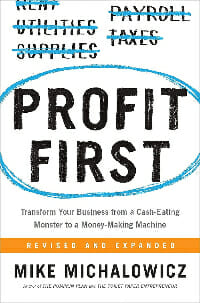I’ve been self-employed for over 20 years, first as a small business owner and then as a freelance writer. One of the biggest challenges I faced early on was learning how to organize my finances, especially when what I earned changed from month to month. I needed a system that would offer some stability, even when the nature of my work as a freelancer was less than stable. My search for a better way to manage my business income led me to Mike Michalowicz’s Profit First book.
If you are an author with multiple streams of income (or in the process of building them), then you get it. The way we do business doesn’t fit neatly into most accounting systems. Freelancers need something a bit more robust or outside-the-box thinking that helps us manage income in a way that makes sense.

I was already familiar with Mike Michalowicz’s writing and his books Toilet Paper Entrepreneur and The Pumpkin Plan, so I picked up Profit First to see if it could offer a new take on accounting that would work for my business. With over 8,400 reviews on Amazon and a 4.8 average rating (not easy to do), I figured the $16.99 might be a good investment.
In this review of the Profit First Method by Mike Michalowicz, we’ll look at:
What is the Profit First method?
The book title leaves little room for guessing (a great example of targeting your reader). The Profit First method is a money (cash) management system that focuses on profits first, then expenses.
In a nutshell, it’s the business version of the envelope (called “plates” in the book) system recommended for personal finances by money experts like Dave Ramsey. Many business owners put themselves last to make sure that everyone else is taken care of first. Profit First is a way to ensure that as the business owner, you don’t get left out of the income equation.
Traditional accounting methods use the formula (simplified): Sales – Expenses = Profit, but with the Profit First method, the formula becomes Sales – Profit = Expenses.
The system works by dispersing income into multiple checking accounts based on predetermined percentages that you can draw from. Ideally, this method helps keep business expenses in their lane without crossing into others.
The methodology leans heavily into Parkinson’s Law, the idea that demand will expand to match supply. In the book, he uses a new tube of toothpaste as an example. When it’s a full tube, we tend to fill our toothbrush from tip to tip, but when there’s a little bit left in the tube, we ration it out. When the supply decreases, we don’t demand as much. He says this works for finances too.
The premise of the book is that if you reduce the demand for money by rationing it out in smaller quantities (smaller plates), you’ll be more likely to manage your money wisely and not overspend. Taking out your profit first gives you less money to work with and forces you to rethink how the money is allocated.
The system is based on the following four fundamental principles:
- Smaller plates – Apply Parkinson’s Law by making the money supply appear smaller. Instead of one operating account, disperse the money between multiple accounts.
- The Primacy Effect – The belief that the order you receive information will determine what you prioritize. When you focus on profit before expenses, you’ll naturally build it first.
- Remove temptation – Take profit off the top and “hide” it so you won’t be tempted to use or spend it until it’s time.
- Enforce a rhythm – Create a habit that will strengthen your financial muscle over the long term and help you make good cash management decisions.
An interesting point that he makes in the book is that if you run out of money in one expense account, it doesn’t necessarily mean that you have to pull from another. It’s a clue that you need to reduce expenses in that particular account which leads to healthier finances.
Who is the book for?
The money management system outlined in the book is ideal for small business owners with predictable monthly revenue who are focused on slow growth and getting a handle on their expenses. It can also work for freelancers with less predictable income which I mention in the takeaway section of this article.
Who is the book not for?
- Those who don’t have a solid understanding of how business finances work.
- Those who don’t have a predictable recurring income (e.g. steady passive income, client contracts, etc.)
- Those who can’t hit specific financial targets each month.
- Those who don’t have the time to manage multiple accounts
Does the Profit First method fulfill its promise?
Michael Michalowicz does an excellent job of explaining the Profit First system. You don’t have to be a financial expert to understand how it works. He uses plain language that a novice can understand, and it’s highly entertaining for a finance book. I laughed out loud at some of his examples about his business owner mishaps. I appreciate his transparency. He leaves you with the feeling that despite his tremendous success, he gets it.
Who is Mike Michalowicz and why is he qualified to write this book?
He’s an entrepreneur, author, and business consultant who has launched and sold several businesses. He’s built his writing business on the back of his failures as a business owner as he learned how to overcome them to achieve success. He got the idea for Profit First after losing all of his money after pride and overspending caused him to make poor business decisions and lose focus on what mattered most.
Overall thoughts and takeaway
It’s an intriguing premise. I recently started implementing the principles in my own author business. The biggest challenge to the system is still the unpredictable monthly income, but others who’ve used the system have recommended taking a larger profit percentage on higher income months to offset the lower ones.
Admittedly, on the surface, the system didn’t sound right. Wouldn’t taking profit off the top first set you up for failure in the long run? From my experience so far, it doesn’t appear to be so.
Would I recommend this book to authors and small business owners in general? Sure. It’s a proven system, and I believe in giving anything a try if it can help me in the long run. Just remember that this system takes work and recurring revenue to be a viable option for money management.
For anyone serious about building a profitable freelance business instead of the feast or famine loop that’s familiar to freelancers, Profit First by Michael Michalowicz is worth a space on your bookshelf.
Listen to the full interview
What are the other books by Mike Michalowicz?
Read more books from Mike Michalowicz::
- All In
- Clock Work
- Get Different
- Fix This Next
- My Money Bunnies
- The Pumpkin Plan
- Surge
- The Toilet Paper Entrepreneur
Did you enjoy this review? Read other book reviews done by the selfpublishing.com team!
























